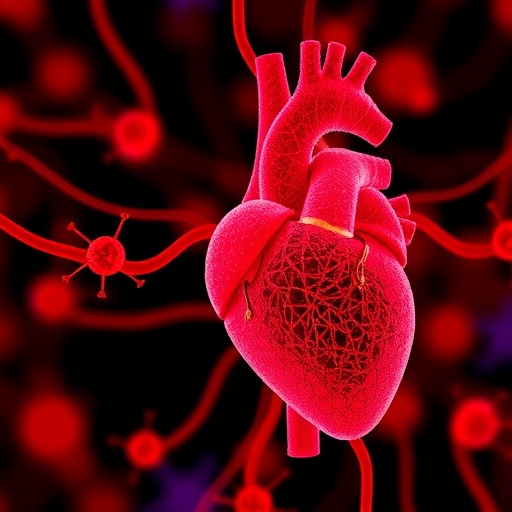In a groundbreaking study, researchers have ventured into the realm of engineered immune-driven theranostics, presenting a novel approach that could revolutionize clinical cardiology. This innovative methodology merges diagnostics with therapeutics, potentially paving the way for highly personalized treatment regimes. Historically, cardiovascular diseases have posed a significant challenge to global health, contributing to millions of deaths annually. With recent advances in biomedicine, the integration of immunology into the diagnosis and treatment of cardiovascular disorders represents a significant leap forward.
The study, led by Zheng, JB., along with Li, XY. and Zhu, JM., examines the application of immune-driven strategies in cardiology, a field that has traditionally not leveraged the power of the immune system as effectively as oncology. The importance of understanding the immune landscape in cardiovascular health cannot be overstated; the interaction between immune cells and cardiovascular tissues can influence the progression of diseases such as atherosclerosis and myocardial infarction. By investigating these interactions, the researchers aim to harness the immune response for therapeutic benefits.
One of the core components of their research involves the use of engineered immune cells designed to target specific cardiovascular issues. These cells are engineered to recognize pathogenic factors associated with heart diseases and respond accordingly. The engineered immune cells could activate a therapeutic response that not only addresses existing cardiac conditions but also prevents them from occurring in the first place. This preemptive approach could significantly alter the treatment landscape in cardiology by shifting the focus from reactive to proactive care.
To elucidate how these engineered immune cells function, the study provides detailed insights into their mechanisms. Perhaps one of the most intriguing aspects is their ability to recognize cardiovascular-specific antigens. By creating a tailored immune response, these cells can selectively target diseased cells while sparing healthy ones. Such specificity reduces the risk of adverse effects, a significant concern in current therapeutic approaches that often affect both healthy and diseased cells alike.
In addition to their immunotherapeutic functions, these engineered cells may serve significant diagnostic purposes as well. By encapsulating biomarkers indicative of cardiovascular diseases within these immune cells, physicians could employ them not just as treatment agents but also as advanced diagnostic tools. This dual capability reinforces the concept of theranostics, whereby a single agent can provide both diagnostic and therapeutic functionalities, a promising direction for clinical practice.
The study also scrutinizes the potential implications of these findings on personalized medicine. The ability to engineer immune cells tailored to an individual’s specific pathophysiological state marks a significant advance over the traditional “one-size-fits-all” approach prevalent in many therapeutic strategies. By customizing treatment to align with the unique immune responses of patients, clinicians could maximize the effectiveness of interventions while minimizing side effects, ultimately leading to improved patient outcomes.
Furthermore, the researchers delve into the possible synergies that could arise from combining these engineered immune approaches with existing cardiology practices. For instance, how might immune-driven therapies function in conjunction with traditional medications or surgical interventions? Integrating these novel therapies with conventional modalities could enhance overall efficacy and broaden the therapeutic landscape for cardiovascular diseases.
Despite the excitement surrounding this novel approach, the study does not shy away from acknowledging potential challenges. There are myriad factors that could impede the successful translation of engineered immune therapies from bench to bedside. These include regulatory hurdles, the need for extensive clinical trials, and the potential for unexpected immunogenic responses in patients. As scientists manipulate the immune system, a thorough understanding of its complexities is crucial.
Moreover, the broader implications of this research extend beyond individual patients. As healthcare systems worldwide grapple with the escalating burden of cardiovascular diseases, the advent of engineered immune therapies could offer scalable solutions. If proven effective, these therapies have the potential to reduce healthcare costs significantly by preventing severe disease states that necessitate expensive interventions.
In conclusion, Zheng, JB., Li, XY., and Zhu, JM.’s research represents a pioneering effort to bridge the gap between immunology and cardiology. The concept of engineered immune-driven theranostics presents a new frontier in clinical practice, signaling a move towards precision medicine in cardiology. As the researchers continue their work, the hope is to refine these strategies further and to implement them in clinical settings, ultimately transforming the landscape of cardiovascular care for future generations.
In essence, the future of cardiology may be intertwined with the advances made in immunology, and the possibility that engineered immune cells could revolutionize both the diagnosis and treatment of heart diseases is an exciting prospect. This study ignites a spark of optimism in a field that has long required innovative strategies to combat the challenges posed by cardiovascular diseases effectively.
Subject of Research: Engineered immune-driven theranostics in clinical cardiology
Article Title: Engineered immune-driven theranostics for clinical cardiology
Article References:
Zheng, JB., Li, XY., Zhu, JM. et al. Engineered immune-driven theranostics for clinical cardiology. Military Med Res 12, 76 (2025). https://doi.org/10.1186/s40779-025-00664-6
Image Credits: AI Generated
DOI: https://doi.org/10.1186/s40779-025-00664-6
Keywords: Engineered immune cells, theranostics, precision medicine, cardiovascular disease, immunotherapy




